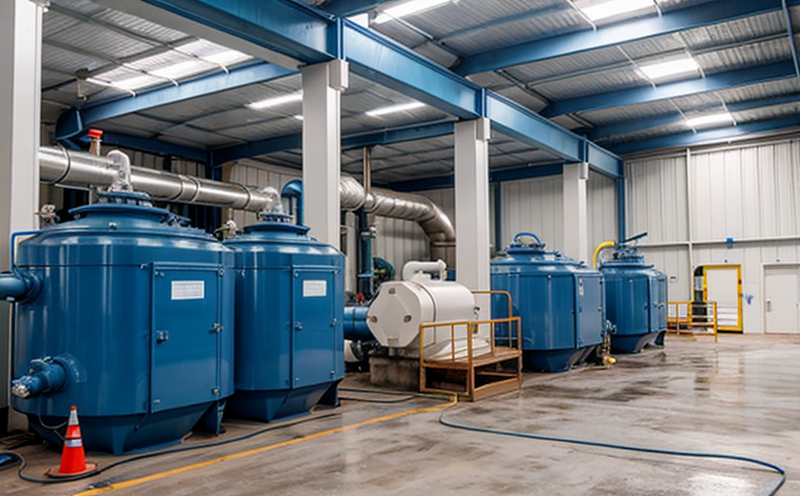ASTM D1293 pH Testing of Ballast and Wastewater
The ASTM D1293 standard is a critical tool used by marine and ship equipment testing laboratories to ensure that ballast water and wastewater meet the stringent international requirements set forth by the International Maritime Organization (IMO) under its Ballast Water Management Convention. This convention aims to prevent the spread of invasive species, pathogens, and other harmful organisms between different maritime regions.
The ASTM D1293 standard provides a clear method for measuring the pH of ballast water and wastewater samples. The pH level is an essential parameter as it can significantly affect the biological stability and treatment efficiency of these waters. A deviation from the acceptable pH range could indicate that the water has been inadequately treated or contains harmful organisms.
The testing procedure specified in ASTM D1293 involves several steps, including sample collection, preparation, and analysis using appropriate instrumentation. Sample collection should follow best practices to ensure the integrity of the sample, which is critical for accurate pH measurement. The collected samples are then prepared according to the standard's requirements before being analyzed.
The analytical process typically utilizes a pH meter with a precision grade suitable for environmental monitoring. It is important that the pH meter used is certified and regularly calibrated to ensure accuracy. Calibration should be performed using buffers of known pH values, which help in establishing the linearity and reproducibility of the instrument's measurements.
The results obtained from ASTM D1293 are typically reported as the average pH value of multiple samples taken over a specified period. Compliance with international standards such as ISO 14050 (Environmental Management Systems) is essential for ensuring that the testing process is conducted in an environmentally responsible manner. This includes minimizing waste, reducing energy consumption, and adhering to all relevant regulations.
The importance of ASTM D1293 pH testing cannot be overstated, especially given the global maritime industry's environmental impact. By accurately measuring the pH levels of ballast water and wastewater, marine operators can ensure that their vessels comply with international regulations and contribute positively to environmental sustainability efforts.
Understanding the broader context of marine equipment testing is crucial for interpreting the significance of ASTM D1293 pH testing. Marine equipment testing encompasses a wide range of activities aimed at ensuring the safety, reliability, and efficiency of ships and related equipment. This includes not only ballast water management but also other critical areas such as fuel oil analysis, corrosion testing, and structural integrity assessment.
In summary, ASTM D1293 pH testing is an indispensable part of the marine industry's efforts to maintain environmental standards and ensure compliance with international regulations. By adhering to this standard, marine operators can play a vital role in preventing the introduction of invasive species into new environments while contributing positively to global sustainability goals.
Industry Applications
The ASTM D1293 pH testing is widely utilized across various sectors within the maritime industry. Quality managers, compliance officers, and R&D engineers rely on this standard to ensure that ballast water and wastewater are treated effectively and meet international standards.
- Quality Management: Ensuring consistent quality in marine equipment through rigorous testing protocols as per ASTM D1293.
- Compliance Officers: Verifying adherence to IMO regulations on ballast water management, ensuring ships are not a vector for invasive species or pathogens.
- R&D Engineers: Developing and refining wastewater treatment systems by testing their effectiveness in maintaining optimal pH levels as per ASTM D1293 standards.
The standard's application extends beyond mere compliance; it also plays a crucial role in the R&D process for new ballast water treatment technologies. By providing accurate pH data, ASTM D1293 helps engineers identify potential improvements and optimize systems to meet stringent international standards.
Quality and Reliability Assurance
- Instrument Calibration: Ensuring that all pH meters used for ASTM D1293 testing are regularly calibrated using certified buffers to maintain accuracy and reliability.
- Data Verification: Cross-referencing results with other relevant tests, such as microbial content analysis, to ensure comprehensive quality assurance.
The process of ASTM D1293 pH testing is designed to minimize errors and ensure the highest level of reliability. Rigorous calibration procedures and data verification steps are critical in maintaining the integrity of the test results.
Compliance with international standards such as ISO 14050 is essential for ensuring that the testing process adheres to environmental best practices. This includes minimizing waste, reducing energy consumption, and complying with all relevant regulations.
The use of certified laboratories equipped with state-of-the-art instrumentation further enhances the reliability and accuracy of ASTM D1293 pH tests. These labs employ trained technicians who are proficient in following the prescribed procedures meticulously to ensure consistent results across multiple samples.
Environmental and Sustainability Contributions
- Invasive Species Prevention: By ensuring that ballast water and wastewater have optimal pH levels, ASTM D1293 helps prevent the introduction of invasive species into new environments, thereby supporting biodiversity conservation efforts.
- Emission Reduction: Optimal pH levels contribute to more efficient treatment processes, which can lead to reduced energy consumption and lower greenhouse gas emissions in ship operations.
The environmental impact of the maritime industry is significant, but ASTM D1293 plays a crucial role in mitigating some of these impacts. By ensuring that ballast water and wastewater are properly treated, this standard helps prevent the spread of invasive species, pathogens, and harmful organisms into new environments.
Moreover, by promoting efficient treatment processes, ASTM D1293 contributes to the reduction of energy consumption and greenhouse gas emissions in ship operations. This not only supports global sustainability goals but also enhances the overall environmental performance of the maritime industry.
The standard's focus on quality assurance and reliability ensures that the testing process is conducted efficiently and effectively, thereby minimizing the environmental footprint associated with ASTM D1293 pH testing. By adhering to this standard, marine operators can contribute positively to global sustainability efforts while ensuring compliance with international regulations.





